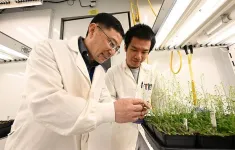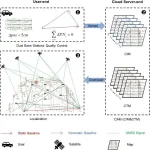(Press-News.org) A Cleveland Clinic-led team of scientists and physicians have discovered that the immune checkpoint protein VISTA can directly turn off tumor-fighting T-cells during immunotherapy and resist treatment.
The study, published in Science Immunology, explains that VISTA can bind to a protein called LRIG1 in T cells, which was previously only thought to promote bone and fat development. When VISTA binds to LRIG1, the researchers found, LRIG1 sends signals that suppress T cell replication, survival and function. This interaction can happen between molecules on tumor cells and on T cells, molecules on healthy cells and T cells and even between molecules on the same T cell. Their preclinical work suggests that blocking LRIG1 function can halt tumor growth in many cancers. In human melanoma and endometrial cancer, LRIG1 expression in tumor-associated T cells was correlated with resistance to immunotherapy.
VISTA modulates the immune responses of healthy cells to keep them from attacking our own bodies, protecting us from autoimmune issues. However, studies from a group led by Li Lily Wang, PhD, of Cleveland Clinic, have shown that during immunotherapy, VISTA impairs immune activation and prevents T cells from attacking cancer cells. Pharmeceutical companies have tried to make therapeutics to block VISTA from working during immunotherapy. Success has been limited, because the field still does not know exactly how VISTA works.
The findings from this study follow another discovery from the laboratory of Dr. Wang, Translational Hematology and Oncology that showed VISTA indirectly suppresses our immune systems by promoting cells called myeloid-derived suppressor cells (MDSCs) that are well known to block T-cell function.
“Our two discoveries combined create a paradigm that explains how VISTA can act as a ‘super villain’ that uses many different weapons to impair antitumor responses during cancer treatments,” says Dr. Wang. “This is an insight that drug developers need to consider if they want to boost treatment response rates to their full potential.”
Immunotherapies and immune checkpoint therapies were a huge breakthrough in cancer treatments, providing hope for individuals affected by previously incurable cancers. But with response rates of only 20% - 30% and high recurrence rates, Dr. Wang says there is still much room to improve.
“Studying the molecular aspect of how LRIG1 functions as VISTA’s receptor on T cells can provide insights on how to successfully block VISTA and improve the clinical outcomes of the patients who don’t respond to existing immune therapies” says lead first author Hieu Minh Ta, PhD.
This project was a collaboration between labs led by Dr. Wang and Timothy Chan, MD, PhD, Chair of Cleveland Clinic's Center for Immunotherapy & Precision Immuno-Oncology, Director of the Global Center for Immunotherapy and Sheikha Fatima bint Mubarak Endowed Chair in Immunotherapy. The paper has four co-first authors: postdoctoral fellows Dr. Ta and Dia Roy, PhD; research associate Keman Zhang, PhD; and project staff Tyler Alban, PhD.
The scientists worked closely with physicians including Brian Gastman, MD, Cleveland Clinic surgical oncologist, and Case Western Reserve University cancer pathologist Stefanie Avril, MD. Drs. Gastman and Avril provided the research team with melanoma and endometrial samples for studying the expression of LRIG1.
The results were striking. Patients who had been more resistant to immunotherapy had higher levels of LRIG1 in their tumor-fighting T cells.
“Our findings in human cancer samples inform and support the decision to go after LRIG1 as a potential drug target for new immune checkpoint therapies,” says study co-first author Dia Roy, PhD.
The lab is now collaborating with many additional clinicians across Cleveland Clinic to learn more about how the VISTA/LRIG1 axis works in regulating immune responses against different cancer types including lung cancer and breast cancer. They expect that combining VISTA-specific inhibitors with existing immunotherapies may reduce resistance and recurrence and improve cancer patient survival.
END
Cleveland Clinic research finds VISTA directly blocks T-cells from functioning in immunotherapy
The protein VISTA combines with a newly discovered inhibitory receptor LRIG1 to directly block T cells from working during immunotherapy.
2024-05-17
ELSE PRESS RELEASES FROM THIS DATE:
Pagan-Christian trade networks supplied horses from overseas for the last horse sacrifices in Europe
2024-05-17
Horses crossed the Baltic Sea in ships during the Late Viking Age and were sacrificed for funeral rituals, according to research from Cardiff University.
Published in the journal Science Advances, studies on the remains of horses found at ancient burial sites in Russia and Lithuania show that they were brought overseas from Scandinavia utilising expansive trade networks connecting the Viking world with the Byzantine and Arab Empires.
Up to now, researchers had believed sacrificial horses were always locally-sourced stallions. ...
University of Bristol researchers develop world’s smallest quantum light detector on a silicon chip
2024-05-17
Researchers at the University of Bristol have made an important breakthrough in scaling quantum technology by integrating the world’s tiniest quantum light detector onto a silicon chip.
A critical moment in unlocking the information age was when scientists and engineers were first able to miniaturise transistors onto cheap micro-chips in the 1960s.
Now, for the first time, University of Bristol academics have demonstrated the integration of a quantum light detector – smaller than a human hair – onto a silicon chip, moving us one step closer to the age of quantum technologies using light.
Making high performance electronics ...
Gut bacteria boost immune response to fight tumors
2024-05-17
Roughly one in five cancer patients benefits from immunotherapy – a treatment that harnesses the immune system to fight cancer. Such an approach to beating cancer has seen significant success in lung cancer and melanoma, among others. Optimistic about its potential, researchers are exploring strategies to improve immunotherapy for cancers that don’t respond well to the treatment, with the hope of benefiting more patients.
Now, researchers at Washington University School of Medicine in St. Louis have found, in ...
How heatwaves are affecting Arctic phytoplankton
2024-05-17
The basis of the marine food web in the Arctic, the phytoplankton, responds to heatwaves much differently than to constantly elevated temperatures. This has been found by the first targeted experiments on the topic, which were recently conducted at the Alfred Wegener Institute’s AWIPEV Station. The phytoplankton’s behaviour primarily depends on the cooling phases after or between heatwaves, as shown in a study just released in the journal Science Advances.
Heatwaves, which we’ve increasingly seen around the globe in recent years, are also becoming more and ...
NUS scientist Professor Lim Chwee Teck elected Fellow of the Royal Society
2024-05-17
Professor LIM Chwee Teck, Director of the Institute for Health Innovation & Technology at the National University of Singapore (NUS iHealthtech) and NUSS Professor, has been elected to the prestigious Fellowship of the Royal Society, in recognition of his invaluable contributions to science.
The Royal Society is the world's oldest and most esteemed scientific academy in continuous existence, as well as the United Kingdom’s national academy of sciences. Fellows are elected annually, and candidates are evaluated based on their exceptional achievements in science. This ...
Modern plant enzyme partners with surprisingly ancient protein
2024-05-17
UPTON, N.Y. — Scientists from the U.S. Department of Energy’s (DOE) Brookhaven National Laboratory have discovered that a protein responsible for the synthesis of a key plant material evolved much earlier than suspected. This new research explored the origin and evolution of the biochemical machinery that builds lignin, a structural component of plant cell walls with significant impacts on the clean energy industry.
When the first land plants emerged from aquatic environments, they needed to adapt in order to survive.
Chang-Jun Liu, a senior scientist in Brookhaven’s Biology ...
Ion irradiation offers promise for 2D material probing
2024-05-17
Two-dimensional materials such as graphene promise to form the basis of incredibly small and fast technologies, but this requires a detailed understanding of their electronic properties. New research demonstrates that fast electronic processes can be probed by irradiating the materials with ions first.
A collaboration involving researchers at the University of Illinois Urbana-Champaign and the University of Duisburg-Essen has shown that when graphene is irradiated with ions, or electrically charged atoms, the electrons that are ejected ...
Scientists develop new geochemical ‘fingerprint’ to trace contaminants in fertilizer
2024-05-17
DURHAM N.C. – An international team of scientists has uncovered toxic metals in mineral phosphate fertilizers worldwide by using a new tool to identify the spread and impact of such contaminants on soil, water resources, and food supply.
“While mineral phosphate fertilizers are critical to boost global sustainable agriculture and food security, we found high levels of toxic metals in many fertilizers worldwide,” said Avner Vengosh, chair of the Earth and Climate Sciences division at Duke University’s Nicholas School of the Environment. “Our study developed a new method to identify sources and impacts of these metals on the environment.” Those ...
From the road to the cloud: leveraging vehicle GNSS raw data for spatial high-resolution atmospheric mapping and user positioning
2024-05-17
Innovative Global Navigation Satellite System (GNSS) positioning technologies harness massive vehicle-generated data to create high-resolution atmospheric delay correction maps, significantly enhancing Global Positioning System (GPS) accuracy across varied spatial scales. This new method exploits real-time, crowd-sourced vehicle GNSS raw data, refining traditional GPS applications and presenting a cost-effective solution for precise positioning.
The quest for enhanced Global Navigation Satellite System (GNSS) accuracy has been hindered ...
Study suggests that air pollution promotes inflammation in the brain, accelerating cognitive decline and increasing risk of dementia
2024-05-17
Results from new study suggests that long-term exposure to air pollution leads to increased risk in dementia in Denmark.
"We also find association with noise, but this seems to be explained by air pollution primarily. Our study is in line with growing international knowledge on this topic." says Professor at Section of Environmental Health Zorana Jovanovic Andersen.
This is an important finding which adds that air pollution, beyond well-known effects on respiratory and cardiovascular system, also has major impacts on our brain, promoting inflammation in the brain, accelerating cognitive decline, and increasing ...
LAST 30 PRESS RELEASES:
Electrodes created using light
Second-hand gift-giving is a well-deliberated decision
How human interaction drove evolution to make bears less aggressive
National Poll: Few parents offer teens guidance on healthy eating during holiday season
Cannabis derivatives could provide new ovarian cancer treatments
Raising strong yeast as a petroleum substitute
Clues to the origin of hot Jupiters hidden in their orbits
Canada’s reduced pledge to Global Fund will impact domestic health
1 in 4 children with major traumatic injuries not cared for in pediatric trauma centres
Duke and Duke-NUS’ joint cross-population research to uncover "East-West" differences in disease and care
Scientists to ‘spy’ on cancer- immune cell interactions using quantum technology breakthrough
Tech savvy users have most digital concerns
Making lighter work of calculating fluid and heat flow
Normalizing blood sugar can halve heart attack risk
Lowering blood sugar cuts heart attack risk in people with prediabetes
Study links genetic variants to risk of blinding eye disease in premature infants
Non-opioid ‘pain sponge’ therapy halts cartilage degeneration and relieves chronic pain
AI can pick up cultural values by mimicking how kids learn
China’s ecological redlines offer fast track to 30 x 30 global conservation goal
Invisible indoor threats: emerging household contaminants and their growing risks to human health
Adding antibody treatment to chemo boosts outcomes for children with rare cancer
Germline pathogenic variants among women without a history of breast cancer
Tanning beds triple melanoma risk, potentially causing broad DNA damage
Unique bond identified as key to viral infection speed
Indoor tanning makes youthful skin much older on a genetic level
Mouse model sheds new light on the causes and potential solutions to human GI problems linked to muscular dystrophy
The Journal of Nuclear Medicine ahead-of-print tip sheet: December 12, 2025
Smarter tools for peering into the microscopic world
Applications open for funding to conduct research in the Kinsey Institute archives
Global measure underestimates the severity of food insecurity
[Press-News.org] Cleveland Clinic research finds VISTA directly blocks T-cells from functioning in immunotherapyThe protein VISTA combines with a newly discovered inhibitory receptor LRIG1 to directly block T cells from working during immunotherapy.






